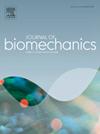利用有限元模拟技术分析关节软骨样本几何形状对机械响应和性能的影响
IF 2.4
3区 医学
Q3 BIOPHYSICS
引用次数: 0
摘要
关节软骨的力学测试结果变化很大,给组织表征带来了挑战。造成差异的因素很多,其中之一就是样品的几何形状。我们的研究小组利用原位相位对比增强同步加速器显微层析成像技术,对软骨样本进行无约束压缩(应力松弛)测试,发现机械响应的变异性很高。由于所有样本都来自同一个牛膝,因此假定它们具有相同的机械特性。微尺度断层扫描图像显示样品存在几何不规则性,而通常假定的圆柱形并没有考虑到这些不规则性。我们旨在确定样品形状对无约束压缩机械响应的影响,以及样品几何形状如何影响已识别的机械特性。我们使用一个参数化的 FE 模型,将几何形状的不规则性纳入到实验设计方法中,并通过双向方差分析对结果进行了分析。此外,还同时使用多个分段式特定样品有限元模型进行了材料参数拟合,以评估样品几何形状对材料参数的影响。结果表明,与预定圆柱体相比,平均倾斜样品表面(4°)造成的反作用力降低了 15%。与平均模型相比,同时拟合多个特定样品几何形状会使材料参数发生-70%到+159%的变化。引人注目的是,初始纤维刚度和渗透性分别增加了 137% 和 159%,与使用圆柱形模型参数相比,拟合的均方根误差减少了 ∼2/3。总之,样品几何形状的微小变化会影响性能表征,并能解释软骨力学数据中样品间差异的部分原因。本文章由计算机程序翻译,如有差异,请以英文原文为准。
Influence of articular cartilage sample geometry on mechanical response and properties using finite element simulation
Mechanical testing of articular cartilage yields highly variable results, posing challenges for tissue characterization. Many factors cause variability, one is sample geometry. Using in-situ phase-contrast enhanced synchrotron micro-tomographs of cartilage samples while tested in unconfined compression (stress relaxation) our group found high variability in the mechanical response. Since all samples originated from a single bovine knee, they were assumed to share mechanical properties. Microscale tomography images showed geometric irregularities in samples that were not accounted for in the often assumed intended cylindrical shape. We aimed to determine the influence of sample shape on mechanical response in unconfined compression and how sample geometry affects identified mechanical properties. Using a parametric FE model incorporating geometric irregularities in a Design of Experiments approach, results were analysed with 2-way ANOVA. Furthermore, a material parameter fitting was done with multiple segmented sample-specific finite element models simultaneously to assess the influence of sample geometry on material parameters. Results revealed that the average inclined sample surface (4°) caused a 15 % decrease in reaction forces compared to the intended cylinder. Fitting multiple sample-specific geometries simultaneously altered material parameters between −70 to +159 % compared to the average model. Strikingly, initial fibril stiffness and permeability increased by 137 % and 159 %, while the root-mean-square error of the fit was reduced by ∼2/3 compared to using parameters from a cylindrical shape model. In conclusion, minor variability in sample geometry affects property characterization and can account for some of the inter-sample variability in the mechanical data for cartilage.
求助全文
通过发布文献求助,成功后即可免费获取论文全文。
去求助
来源期刊

Journal of biomechanics
生物-工程:生物医学
CiteScore
5.10
自引率
4.20%
发文量
345
审稿时长
1 months
期刊介绍:
The Journal of Biomechanics publishes reports of original and substantial findings using the principles of mechanics to explore biological problems. Analytical, as well as experimental papers may be submitted, and the journal accepts original articles, surveys and perspective articles (usually by Editorial invitation only), book reviews and letters to the Editor. The criteria for acceptance of manuscripts include excellence, novelty, significance, clarity, conciseness and interest to the readership.
Papers published in the journal may cover a wide range of topics in biomechanics, including, but not limited to:
-Fundamental Topics - Biomechanics of the musculoskeletal, cardiovascular, and respiratory systems, mechanics of hard and soft tissues, biofluid mechanics, mechanics of prostheses and implant-tissue interfaces, mechanics of cells.
-Cardiovascular and Respiratory Biomechanics - Mechanics of blood-flow, air-flow, mechanics of the soft tissues, flow-tissue or flow-prosthesis interactions.
-Cell Biomechanics - Biomechanic analyses of cells, membranes and sub-cellular structures; the relationship of the mechanical environment to cell and tissue response.
-Dental Biomechanics - Design and analysis of dental tissues and prostheses, mechanics of chewing.
-Functional Tissue Engineering - The role of biomechanical factors in engineered tissue replacements and regenerative medicine.
-Injury Biomechanics - Mechanics of impact and trauma, dynamics of man-machine interaction.
-Molecular Biomechanics - Mechanical analyses of biomolecules.
-Orthopedic Biomechanics - Mechanics of fracture and fracture fixation, mechanics of implants and implant fixation, mechanics of bones and joints, wear of natural and artificial joints.
-Rehabilitation Biomechanics - Analyses of gait, mechanics of prosthetics and orthotics.
-Sports Biomechanics - Mechanical analyses of sports performance.
 求助内容:
求助内容: 应助结果提醒方式:
应助结果提醒方式:


